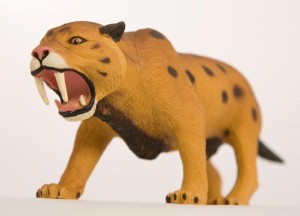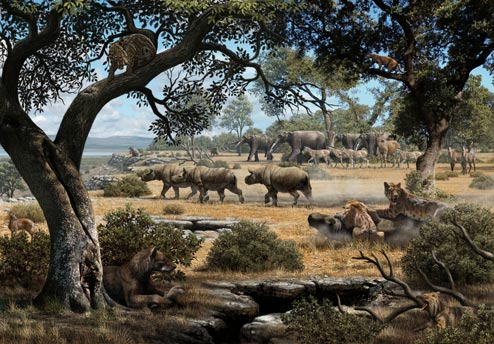Predator/Prey Relationships in Miocene Spain
Joint American and Spanish Team Study Teeth to find out what Sabre-toothed Cats Ate
A ratio of Carbon 12 to Carbon 13 isotopes preserved in the fossilised teeth of apex predators and herbivores that lived over nine million years ago has provided a joint American and Spanish research team with an insight into how food chains worked in the latter part of the Miocene epoch. The study, the academic paper having been published in the scientific journal “The Proceedings of the Royal Society of Biology”, focused on the diets of the top, predatory mammals and attempted to establish how large carnivores such as Sabre-toothed cats and Bear Dogs (amphicyonids) were able to live in the same habitats in the Late Miocene of Spain without necessarily competing for the same food resources.
The Late Miocene of Spain
Palaeontologists from the Museo Nacional de Ciencias Naturales (Madrid) and the University of Michigan (United States) studied the fossilised teeth of specimens of animals that had been found at a number of fossil dig sites at Cerro de los Batallones, just 25 miles south-west of Madrid. A substantial number of vertebrate skeletons have been discovered in this area, two dig sites are particularly rich in predator fossil bones. Scientists suspect these sites represent “natural predator traps”, a herbivore may have become stuck fast in mud and this then attracted a number of carnivores and scavengers to the location hoping to feed on the hapless plant-eater. The meat-eaters soon became stuck too, and the rising pile of corpses would have attracted more and more predators, thus the number of carnivore fossil specimens found at such sites are far in excess of the number of herbivore fossil specimens found. Fossils found include those of hyenas, martens and skunks.
Two Species of Sabre-toothed Cat
The researchers studied two species of Sabre-toothed cat, Promegantereon ogygia, about the size of an African Leopard (Panthero pardus pardus) and the much larger and heavier Machairodus aphanistus, which was about the size of an extant African Lion (Panthero leo). It is quite common to hear people describe Sabre-toothed cats as “Sabre-toothed tigers”, this is an inaccurate description, as although Sabre-tooths do belong to the same taxonomic family as today’s “Big Cats” – Felidae, Sabre-toothed cats are not closely related to tigers.
Identifying the Role of Sabre-toothed Cats in Ancient Food Webs
Picture credit: Everything Dinosaur
Bear Dogs
The other type of apex predator the research team studied was the Bear Dog known as Magericyon anceps. Bear Dogs are neither Bears or Dogs but seem to be distantly related to both types of carnivore, sharing a common vulpavine ancestor. M. anceps was a particularly large and powerful example of the Middle to Late Miocene Bear Dogs, large specimens could weigh over 200 kilogrammes and would have stood over a metre high at the shoulder.
The study of the teeth isotopes revealed that the Sabre-toothed cats shared the same woodland habitat. The smaller Sabre-toothed cat species probably used the abundant cover to avoid encounters with M. aphanistus. Sabre-toothed cats have a different build when compared to modern cats. They are not built for speed but have immensely strong front legs and shoulders. Scientists have speculated that Sabre-toothed cats specialised in being ambush predators rather than pursuit predators, chasing after their prey. The woodland habitat would have been ideal for ambushing herbivores.
Stable Carbon Isotope Analysis
To arrive at their findings, the researchers conducted what’s called a stable carbon isotope analysis on the animals’ teeth. Using a dentist’s drill with a diamond bit, they sampled teeth from 69 specimens, including 27 Sabre-toothed cats and Bear Dogs. The rest were plant-eaters. They isolated the carbon from the tooth enamel. Using a mass spectrometer, which you could think of as a type of scale, they measured the ratio of the more massive carbon 13 molecules to the less-massive carbon 12. An isotope is a version of an element that contains a different number of neutrons in its nucleus.
Carbon 12 and 13 are both present in the carbon dioxide that plants take in during photosynthesis. Different plants make use of the isotopes in different ways, and so they retain different amounts of them in their fibres. When a herbivore eats a plant, that plant leaves an isotopic signature in the animal’s bones and teeth. The signature travels through the food chain and can be found in carnivores as well.
One of the research paper’s authors stated:
“This would be the same in your tooth enamel today. If we sampled them, we could have an idea of what you eat. It’s a signature that remains through time.”
Cerro de los Batallones in the Late Miocene
Picture credit: Mauricio Antón
Late Miocene of Spain
This illustration depicts how the region of Cerro de los Batallones in central Spain likely looked 9 million years ago. A superb scene created by Mauricio Antón and we acknowledge the University of Michigan press information which provided this image.
Both species of Sabre-toothed cat showed no statistical differences in the ratio of Carbon 12 to Carbon 13 in their teeth samples. This means that they probably fed on similar prey animals that lived in the woodlands, but their body sizes probably meant that they targeted different sized prey. They may also have avoided direct competition by hunting at different times of the day. It has been speculated that Promegantereon ogygia may have hunted after dusk, or spent more time in the trees, so as to avoid the attentions of larger types of Sabre-toothed cat in the area. It seems that the members of the Machairodontinae living in the area that was to become central Spain preferred to eat primitive horses, animals that were not yet the highly efficient runners seen on race tracks today.
Tests on Bear Dog Teeth
The tests on the Bear Dog teeth showed a different ratio, indicating that an alternative type of prey was preferred by these carnivores. The Bear Dogs hunted animals that lived in more open, grassland habitats, they seem to have been better suited to pursuit predation, tackling herbivores that lived in open areas such as antelopes.
It seems that nine million years ago, a number of mammalian apex predators were able to co-exist in this part of Europe as they seem to have specialised in hunting different types of prey animal.
Commenting on the study, one of the researchers stated that such investigations using isotope analysis of fossil teeth provided an insight into the diets of long extinct creatures. This in turn gave the palaeontologists an understanding of an ancient, long extinct ecosystem.
For models and replicas of prehistoric mammals including apex predators: Wild Safari Prehistoric Animal Figures and Models.



